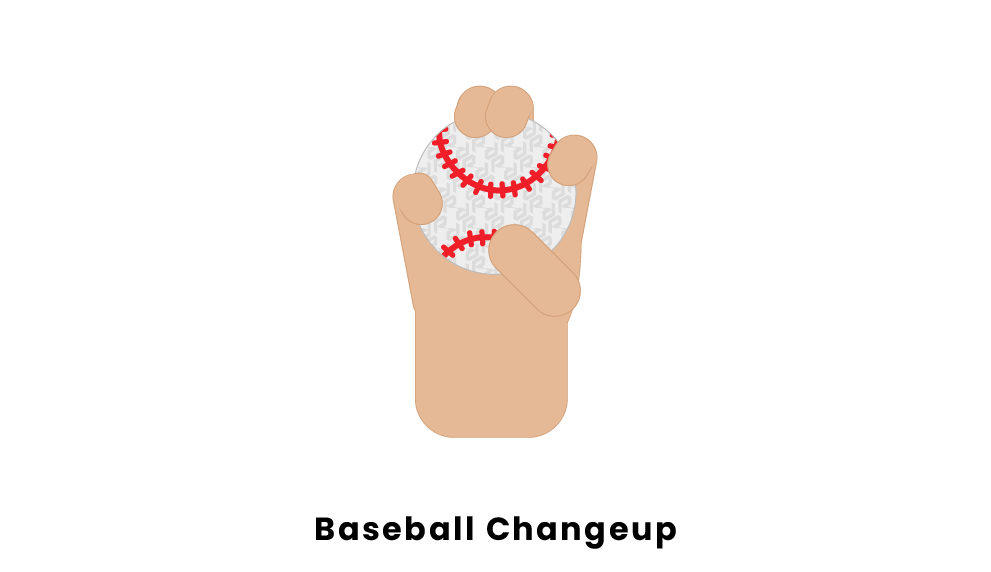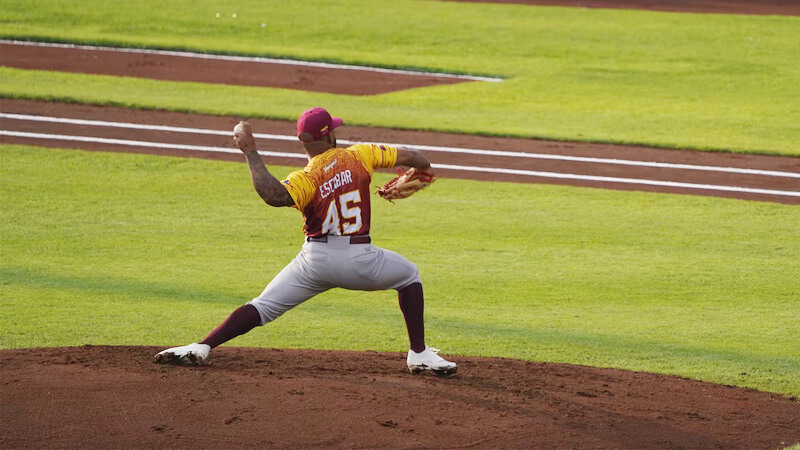In the world of baseball, mastering different pitch types is essential for a pitcher’s success. One such pitch that can leave batters scratching their heads is the changeup. The changeup is a deceptive pitch that relies on altering speed and movement to keep hitters off balance. If you’re looking to add this effective weapon to your pitching arsenal, you’re in the right place. This comprehensive guide will teach you how to throw a changeup in baseball like a pro.
What is a Changeup?

A changeup is a pitch in baseball where the goal is to surprise the batter. It’s usually thrown slower than other pitches and its main purpose is to mess up the hitter’s timing. By disguising the changeup to look like a fastball, a pitcher can catch the batter off guard.
To throw a changeup correctly, the pitcher needs the right grip and arm action. The most common grip is called the “circle change.” Here, the thumb and index finger form a circle around the ball. This grip gives better control and movement of the pitch. The arm action should mimic that of a fastball delivery, to keep the batter from knowing what’s coming.
The key to a changeup is its speed differential. Usually, fastballs are thrown at speeds over 90 mph. But a changeup can go as low as the mid-70s or lower. This sudden decrease in velocity can confuse the hitter and cause them to swing too soon or mess up their timing.
Sandy Koufax, a Hall of Fame pitcher, was known for his powerful changeup when he played for the Los Angeles Dodgers. It was so difficult to hit because of its movement and deception.
Throwing a changeup is an art that requires skill, practice, and understanding of how to use a hitter’s expectations against them. When used right, pitchers can make opposing offenses off balance and increase their chances of success on the mound.
The Grip

Gripping the baseball correctly is key to a successful changeup pitch. Let’s discover the various grips pitchers use to get that desired movement and deception.
Witness The Grips:
| Descriptive Grip | Benefit |
|---|---|
| Circle Changeup | Three fingers on top, with thumb and pinky forming a circle. Faster arm action, creating greater movement and deception. |
| Three-Finger Changeup | Middle, ring, and pinky fingers on top of the ball, thumb pressure. Better control & speed variation than other changeup grips. |
| Vulcan Changeup | Mr. Spock-inspired two fingers between two seams on top of the ball. Unusual release point that confuses batters & leads to more strikes. |
| Palm Ball | Ball secured deep into palm of the hand, minimal finger contact. Alters throwing mechanics resulting in slower velocity. |
Unexpected Insights:
Stable grip & finger pressure are vital for manipulating the ball’s movement in a changeup pitch. Trying different grips can help pitchers find their best technique.
A Charming Tale:
The history of different changeup grips is as captivating as it is varied. LeRoy “Satchel” Paige, an iconic American pitcher during segregation, invented his renowned hesitation pitch while playing for barnstorming teams in exhibition games. This crafty approach required holding and releasing the ball in unusual ways—a precursor to modern changeups.
By understanding each grip’s details, pitchers can flaunt changeups that deceive even the most experienced batters—adding excitement and artistry to America’s favorite pastime.
Pitching Mechanics

Let’s explore the details of Pitching Mechanics! A table gives a visual of the main components: grip, stance, wind-up, stride, arm action, release point, and follow-through.
Understanding each part and how they work together is key to mastering pitching mechanics. By focusing on every aspect, pitchers can enhance their skills.
Grip is one special detail. It affects the ball’s trajectory and movement. Different pitches require different grips, such as four-seam for fastballs or variations for breaking balls like curveballs and sliders.
Pitching mechanics have changed over time. Early on, pitchers relied on natural ability. Now, coaches study mechanics closely. Technology and sports science have helped refine techniques.
Mastering the Changeup: It’s time to show off your grip and watch the batter’s expression change!
Mastering the Changeup

The changeup pitch is tricky to master – it needs precision and finesse! Master it and you can deceive your opponents – game-changer!
Here’s a step-by-step guide to help you out.
- Step 1: Grip. Find a comfortable grip that gives you control and movement on the ball. Try the circle-change or three-fingered grip.
- Step 2: Hand Speed. Maintain the same arm speed as your fastball, so batters can’t guess what’s coming.
- Step 3: Arm Action. Refine your arm action to be like your fastball. Keep arm speed and release point consistent.
- Step 4: Location. Place the changeup in strategic spots in the strike zone. Aim low and away or off the plate.
- Step 5: Change in Tempo. Varying speeds between pitches keeps hitters guessing.
Plus, consider each batter’s weaknesses when you throw the changeup. Analyze scouting reports and study opposing batters’ habits.
Now a story – back in the early 80s a young pitcher named Fernando Valenzuela brought his changeup masterpiece to the game. He won the National League Rookie of the Year and Cy Young Awards in 1981! His changeup baffled batters and made him one of the most powerful pitchers of his time.
Tips and Tricks

Do you want to improve your baseball skills and amp up your pitching repertoire? Mastering the changeup is the key!
Here’s how:
- Change Your Grip: Adjust your grip on the baseball by shifting your fingers slightly off-center. This will create movement and deceive the hitters.
- Vary Your Arm Speed: Throw your changeup at a slower speed than your fastball. The difference in velocity will surprise the batters!
- Maintain Balance: Stay balanced during your delivery for accuracy and to disguise the pitch.
- Master the Release Point: Practice releasing the ball from the same point as your fastball. It’ll be harder for hitters to guess what’s coming.
- Focus on Pronation: As you release the ball, focus on pronating your wrist. This will cause the pitch to drop or fade sharply.
For extra deception, begin with the same arm action as your fastball before quickly changing speeds and grip mid-delivery. Also, keep the same arm angle and motion for both fastballs and changeups. With practice, you’ll make batters swing and miss!
Basic Drills and Exercises

- To master the changeup, warm up your muscles with dynamic stretches for improved range of motion.
- Increase arm strength and throwing distance with long toss drills.
- Target throws with a partner will help improve accuracy and control.
- For better stability and balance, strengthen your core with medicine ball exercises.
- Finish off with conditioning drills like sprints and agility ladder workouts for enhanced overall athleticism.
- Also, incorporate resistance band exercises to strengthen small muscles used in throwing a changeup.
- Vary drills by changing the angle or distance to challenge different aspects of your pitching mechanics.
Encouraged by his coach, one determined young pitcher dedicated extra time to practice his grip and release. After weeks of hard work, he confidently unveiled his changeup during a game. The batter was fooled, swinging at thin air as the ball dipped in front of him. His efforts had paid off!
With drills, exercises, and perseverance, you’ll be well on your way to throwing a killer changeup that will leave batters speechless.
Advanced Tactics

Delve into advanced baseball tactics!
- Pickoff moves can keep baserunners on their toes.
- The squeeze play is a great way to score when the defense is caught off guard.
- The hidden ball trick is a sneaky move.
- Hitting behind runners confuses the defense.
Get ready to be a pitching Picasso! Learn to throw a changeup and leave opponents hitting the punchline.
Application and Practice

Mastering the art of a changeup is key. Applying techniques, and consistently practicing them, can deceive opponents with unexpected pitch speed. This improves overall gameplay.
To help, here’s a table:
| Technique | Description |
|---|---|
| Grip | Hold the ball with three fingers, loose grip. |
| Arm Speed | Maintain consistent speed to disguise pitch. |
| Pronation | Rotate forearm inward to add movement. |
| Release Point | Keep it similar to fastballs for effectiveness. |
| Location | Aim outside the strike zone to fool batters. |
Focusing on balance throughout delivery, and using proper body mechanics, adds power and control.
It’s time to take action! Implement these strategies, refine your skills, and you’ll dominate the mound with confidence. Elevate your game and become a formidable force for your team. Start today!
Frequently Asked Questions
Q: What is a changeup in baseball?
A: A changeup is a pitch in baseball that is meant to deceive the batter by looking like a fastball but has a slower speed and varying movement. It is thrown with the same arm motion and release as a fastball but with a grip that slows down the pitch.
Q: How do you grip a changeup?
A: To grip a changeup, place your index and middle finger across the horseshoe seam on top of the baseball. Your thumb should be placed on the underside of the ball. This grip helps in creating the backspin, which slows down the ball’s flight and also gives it a slight movement.
Q: What is the difference between a changeup and a fastball?
A: The main difference between a changeup and a fastball is the speed. A fastball is usually thrown at maximum effort with the highest velocity, while a changeup is thrown at a slower speed, often 5 – 15mph less than a fastball. Also, the grip and release of the ball are different.
Q: What are some tips to throw a good changeup?
A: Some tips to throw a good changeup include perfecting the grip, working on the arm speed, maintaining a consistent release, throwing it with confidence, and practicing the pitch consistently.
Q: When should a pitcher use a changeup?
A: A pitcher should use a changeup when the batter is expecting a fastball or aggressive swing, or when a pitch with less velocity and movement is required to keep the batter off-balance.
Q: How can a pitcher improve their changeup?
A: A pitcher can improve their changeup by practicing consistently, experimenting with different grips, seeking guidance from experienced coaches or players, watching and analyzing professional baseball pitchers. Also, gaining control over the delivery of the pitch by working on the release and arm speed can improve overall accuracy.
Conclusion
The changeup is a game-changer in a pitcher’s toolkit. It can bamboozle even the most experienced batters. By speeding up or slowing down the pitch, as well as switching up the movement, pitchers can keep hitters off-guard and get more outs. In this article we studied the grip and mechanics for throwing a changeup, with some tips to boost command and deception. Now, let’s discuss the main takeaways and how to further develop your changeup skills.
Throughout the article, we focused on practicing and refining your changeup grip and mechanics. A good grip will help disguise the pitch and give it the desired movement. Also, consistent release points and arm speed will ensure a deceptive delivery. With practice and dedication to perfecting these elements, you can throw a consistent effective changeup.
Having a mental approach that complements the physical execution is also key to mastering the changeup. Have faith in your skill and use it to stay calm and focused on executing each pitch with precision. This confidence in your own ability will help maximize the effectiveness of your changeup.
Lastly, take advice from experienced coaches or teammates who may have helpful insights into further improving your changeup. Listen to constructive criticism and use it to advance as a pitcher.








